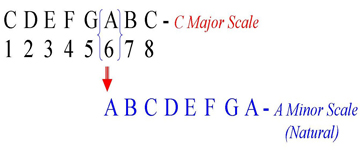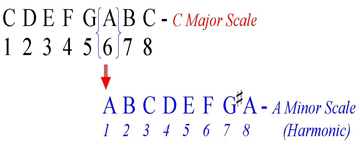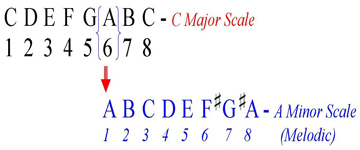Understanding Minor
Scales | Piano Theory
What do you know about minor scales?
As a developing pianist or keyboard player, learning to play different piano scales should be one of your main areas of focus. Among the different scales that exist, all piano players should learn to play at least two types of scale whether it be major, minor or blues.
Although the majority of contemporary musical styles composed today are written in a major key, there are many compositions that are written in minor keys. Like major scales, minor scales have eight notes beginning and ending with the same letter name. It differs however, from the pattern of intervals that are used inmajor scale. This means that the tones and semitones placed in the structure of both scales are organized differently.
Below are illustrations showing the difference in intervals between the minor and major scales.
C MAJOR SCALE

C MINOR

Minor Scales Formula
There are three main types of minor scale that are used in music. They are the natural minor, harmonic minor and melodic minor.
All these scales are constructed from a major scale and are called relative minors.
In a major scale the sixth note is used to create a relative scale which is the minor. For example, in the C major scale the 6th note is “A”. Therefore, “A” will be the root note of the minor scale that is relative to C major.
Even though the natural, harmonic and melodic minors are constructed from a major scale using the sixth note, they are somewhat different.
NATURAL MINOR
When a natural minor is constructed, it uses the same letters of the major scale without any added accidentals (sharps or flats).
Here is an illustration showing how this scale has been constructed from a major scale.

HARMONIC MINOR
The harmonic minor is slightly different from the natural minor. This scale is constructed using the same approach. However, the seventh note is raised.
In other words an accidental (sharp) is added to the seventh note of the harmonic minor.
The illustration below should give a clearer explanation as to how a harmonic minor is constructed.

MELODIC MINOR
A melodic minor is a little more complex than the natural and the harmonic minor. When constructing the melodic minor, the sixth and seventh notes are raised when it is played in ascending order. However, when descending, the sixth and seventh notes are played as natural.
Here is an illustration to explain how melodic minor are constructed and played.

All three scales are very important and so you should not be reluctant in practicing them. However, the harmonic is used more often than all the rest.
As you grow into a mature piano player, never cease from practicing these three scales.
Related lessons on scales
Click here to leave the minor scales page and return to
Subscribe to receive free piano lessons
E-zines and other updates!









